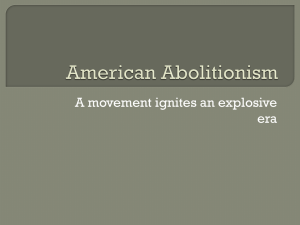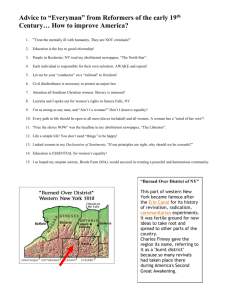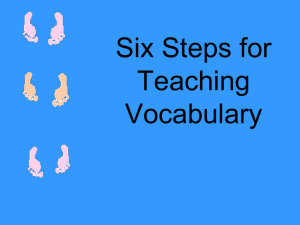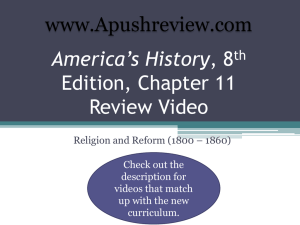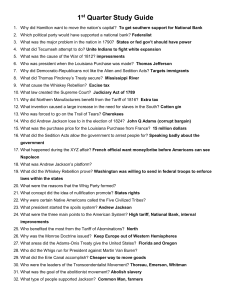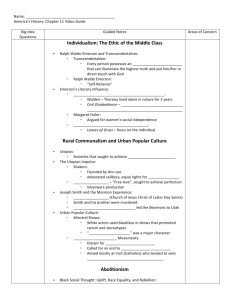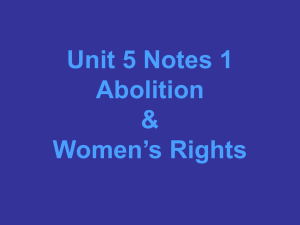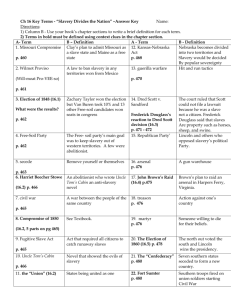Ruminer
advertisement
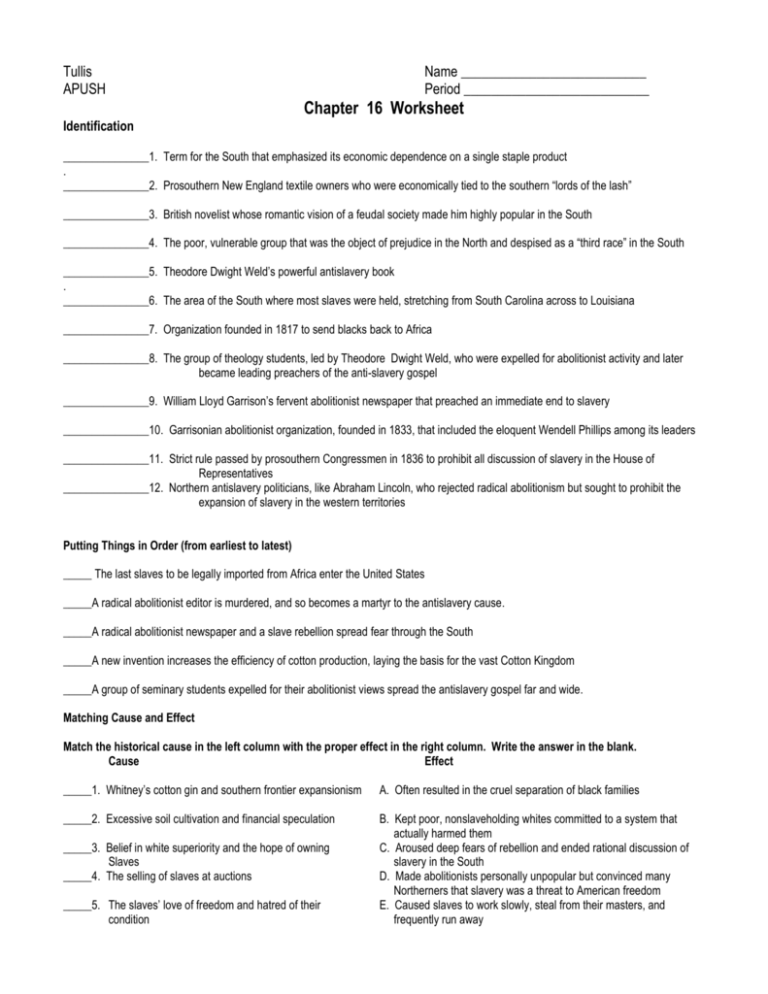
Tullis APUSH Name ___________________________ Period ___________________________ Chapter 16 Worksheet Identification _______________1. Term for the South that emphasized its economic dependence on a single staple product . _______________2. Prosouthern New England textile owners who were economically tied to the southern “lords of the lash” _______________3. British novelist whose romantic vision of a feudal society made him highly popular in the South _______________4. The poor, vulnerable group that was the object of prejudice in the North and despised as a “third race” in the South _______________5. Theodore Dwight Weld’s powerful antislavery book . _______________6. The area of the South where most slaves were held, stretching from South Carolina across to Louisiana _______________7. Organization founded in 1817 to send blacks back to Africa _______________8. The group of theology students, led by Theodore Dwight Weld, who were expelled for abolitionist activity and later became leading preachers of the anti-slavery gospel _______________9. William Lloyd Garrison’s fervent abolitionist newspaper that preached an immediate end to slavery _______________10. Garrisonian abolitionist organization, founded in 1833, that included the eloquent Wendell Phillips among its leaders _______________11. Strict rule passed by prosouthern Congressmen in 1836 to prohibit all discussion of slavery in the House of Representatives _______________12. Northern antislavery politicians, like Abraham Lincoln, who rejected radical abolitionism but sought to prohibit the expansion of slavery in the western territories Putting Things in Order (from earliest to latest) _____ The last slaves to be legally imported from Africa enter the United States _____A radical abolitionist editor is murdered, and so becomes a martyr to the antislavery cause. _____A radical abolitionist newspaper and a slave rebellion spread fear through the South _____A new invention increases the efficiency of cotton production, laying the basis for the vast Cotton Kingdom _____A group of seminary students expelled for their abolitionist views spread the antislavery gospel far and wide. Matching Cause and Effect Match the historical cause in the left column with the proper effect in the right column. Write the answer in the blank. Cause Effect _____1. Whitney’s cotton gin and southern frontier expansionism A. Often resulted in the cruel separation of black families _____2. Excessive soil cultivation and financial speculation B. Kept poor, nonslaveholding whites committed to a system that actually harmed them C. Aroused deep fears of rebellion and ended rational discussion of slavery in the South D. Made abolitionists personally unpopular but convinced many Northerners that slavery was a threat to American freedom E. Caused slaves to work slowly, steal from their masters, and frequently run away _____3. Belief in white superiority and the hope of owning Slaves _____4. The selling of slaves at auctions _____5. The slaves’ love of freedom and hatred of their condition _____6. The religious fervor of the Second Great Awakening _____7. Politically minded abolitionists like Frederick Douglass _____8. Garrison’s Liberator and Nat Turner’s bloody slave rebellion _____9. White southern defenses of slavery as a “positive good” _____10.The constant abolitionist agitation in the North F. Stirred a fervent abolitionist commitment to fight the “sin” of slavery G. Turned the South into a booming one-crop economy where “cotton was king” H. Opposed Garrison and organized the Liberty party and the free soil party I. Created dangerous weaknesses beneath the surface of prosperity of the southern cotton economy J. Widened the moral and political gap between the white South and the rest of the Western world Matching People, Places and Events _____1. Sir Walter Scott _____2. Harriet Beecher Stowe _____3. Nat Turner _____4. Liberia _____5. Theodore Dwight Weld _____6. Lewis Tappan _____7. Lane Theological Seminary _____8. William Lloyd Garrison _____9. David Walker _____10. Sojourner Truth _____11. Martin Delany _____12. Frederick Douglass _____13. Virginia Legislature _____14. John Quincy Adams _____15. Elijah Lovejoy A. B. C. D. E. F. G. H. I. J. K. L. M. N. O. Wealthy New York abolitionist merchant whose home was demolished by a mob in 1834 Visionary black preacher whose bloody slave rebellion in 1831 tightened the reins of slavery in the South Midwestern institution whose president expelled eighteen students for organizing a debate on slavery New York free black woman who fought for emancipation and women’s rights Leading radical abolitionist who burned the Constitution as “a covenant with death and an agreement with hell” Author of an abolitionist novel that portrayed the separation of slave families by auction Site of the last major southern debate over slavery and emancipation, in 1831-1832 English novelist whose romantic medievalism encouraged the semifeudal ideals of the southern planter aristocracy Black abolitionist who visited West Africa in 1859 to examine sites where African-Americans might relocate Former president who fought for the right to discuss slavery in Congress Illinois editor whose death at the hands of a mod made him an abolitionist martyr West African republic founded in 1822 by freed blacks from the United States Escaped slave and great black abolitionist who fought to end slavery through political action Black abolitionist writer who called for a bloody end to slavery in an appeal of 1829 Leader of the “Lane Rebels” who wrote the powerful antislavery work American Slavery as it Is
